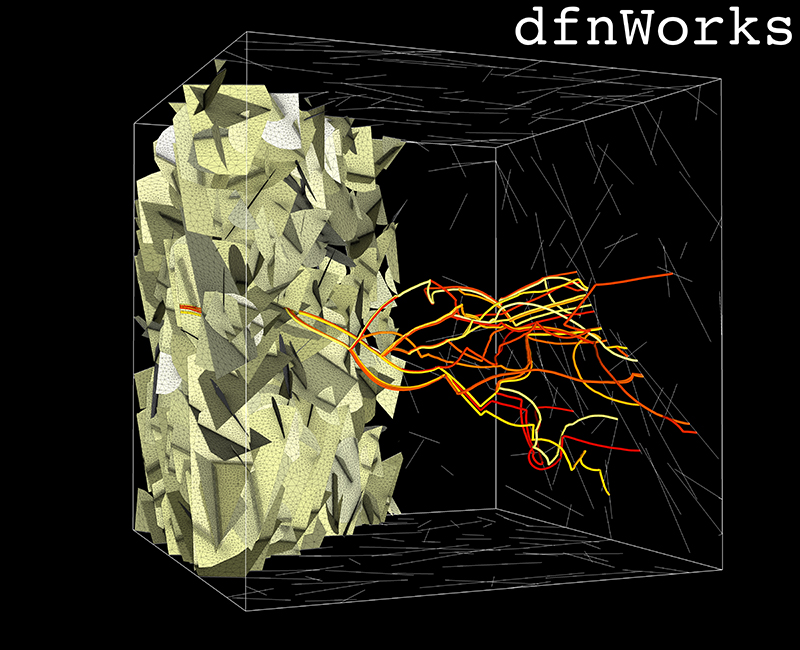dfnWorks

The computational software suite dfnWorks positions the Lab to address potential new projects that will utilize this alternative approach to modeling flow and transport in fractured subsurface environments.
dfnworks is a parallelized computational suite to generate three-dimensional discrete fracture networks (DFN) and simulate flow and transport.
Developed at Los Alamos National Laboratory since 2011, dfnWorks has been used to study flow and transport in fractured media at scales ranging from millimeters to kilometers.
The dfnworks suite mitigates this principal drawback of high computational cost, and allows researchers to perform numerical experiments of flow and transport through fractured porous media which were previously deemed unfeasible.
The networks are created and meshed using dfnGen, which combines FRAM (the feature rejection algorithm for meshing) methodology to stochastically generate three-dimensional DFNs on the basis of site specific data with the LaGriT meshing toolbox to create a high-quality computational mesh representation, specifically a conforming Delaunay triangulation suitable for high performance computing finite volume solvers, of the DFN in an intrinsically parallel fashion.
Flow through the network is simulated in dfnFlow, which utilizes the massively parallel subsurface flow and reactive transport finite volume code PFLOTRAN.
A Lagrangian approach to simulating transport through the DFN is adopted within dfnTrans, which is an extension of the of the walkabout particle tracking method to determine pathlines through the DFN.
Hyman, J.D., Karra, S., Makedonska, N., Gable, C.W., Painter, S.L. and Viswanathan, H.S. dfnWorks: A discrete fracture network framework for modeling subsurface flow and transport. Computers & Geosciences 84 (2015a), 10–19.
Hyman, J.D., S. L. Painter, H. S. Viswanathan, N. Makedonska, S. Karra, Influence of injection mode on transport properties in kilometer-scale three-dimensional discrete fracture networks, Water Resources Research 51(9) (2015) 7289–7308. (2015b).
Karra, S., N. Makedonska, H. Viswanathan, S. Painter, J. Hyman, Effect of advective flow in fractures and matrix diffusion on natural gas production, Water Resources Research 51(10) (2015) 8646-8657.
Makedonska, N., S.L. Painter, Q. M. Bui, C.W. Gable, and S. Karra, Particle tracking approach for transport in three-dimensional discrete fracture networks, Computational Geosciences, pp. 1-15, 2015.
Middleton, Richard S., et al., Shale gas and non-aqueous fracturing fluids: Opportunities and challenges for supercritical CO2, Applied Energy 147 (2015): 500-509.
O'Malley D, Karra S, Currier RP, Makedonska N, Hyman JD, Viswanathan HS. Where Does Water Go During Hydraulic Fracturing?. Groundwater. 2015 Oct 1.
Hyman, J.D., Gable, Carl W., Painter, Scott L., and Makedonska, Nataliia, Conforming Delaunay Triangulation of Stochastically Generated Three Dimensional Discrete Fracture Networks: A Feature Rejection Algorithm for Meshing Strategy, SIAM Journal on Scientific Computing 36.4 (2014): A1871-A1894






